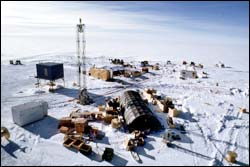This area deals with the fundamental laws and building blocks of nature and how they interact, the properties and the behavior of matter, and research into space and time and their structures.
innovations-report provides in-depth reports and articles on subjects such as astrophysics, laser technologies, nuclear, quantum, particle and solid-state physics, nanotechnologies, planetary research and findings (Mars, Venus) and developments related to the Hubble Telescope.

Scientists report in Nature today that significantly fewer asteroids could hit the Earth’s surface than previously reckoned.
Researchers from Imperial College London and the Russian Academy of Sciences have built a computer simulation that predicts whether asteroids with a diameter up to one kilometre (km) will explode in the atmosphere or hit the surface.
The results indicate that asteroids with a diameter greater than 200 metres (the length of two football pitches) will hi

Peering back in time more than 7 billion years, a team of astronomers using a powerful new spectrograph at the W. M. Keck Observatory in Hawaii has obtained the first maps showing the distribution of galaxies in the early universe. The maps show the clustering of galaxies into a variety of large-scale structures, including long filaments, empty voids, and dense groups and clusters.
These maps are among the first results from the DEEP2 Redshift Survey, an ongoing three-year project d

ESA PR 44-2003. A unique view of our home planet and its natural satellite – the Moon – is one of the first data sets coming from ESA’’s Mars Express.
“It is very good news for the mission,” says ESA’’s Mars Express Project Scientist, Agustin Chicarro. These and other data, such as those recording the major constituents of Earth as seen from space, are the actual proof that the instruments on board Mars Express, launched 2 June 2003, are working perfectly.
The routine check-outs

Using the powerful trick of gravitational lensing, a European and American team of astronomers have constructed an extensive ‘mass map’ of one of the most massive structures in our Universe. They believe that it will lead to a better understanding of how such systems assembled and the key role of dark matter.
Clusters of galaxies are the largest stable systems in the Universe. They are like laboratories for studying the relationship between the distributions of dark and visible matter. In 1

A novel telescope that uses the Antarctic ice sheet as its window to the cosmos has produced the first map of the high-energy neutrino sky.
The map, unveiled for astronomers here today (July 15) at a meeting of the International Astronomical Union, provides astronomers with their first tantalizing glimpse of very high-energy neutrinos, ghostly particles that are believed to emanate from some of the most violent events in the universe – crashing black holes, gamma ray bursts, and the

Discovery of quadruply lensed quasar with Einstein ring
Using the ESO 3.6-m telescope at La Silla (Chile), an international team of astronomers [1] has discovered a complex cosmic mirage in the southern constellation Crater (The Cup). This “gravitational lens” system consists of (at least) four images of the same quasar as well as a ring-shaped image of the galaxy in which the quasar reside – known as an “Einstein ring”. The more nearby lensing galaxy that causes this intriguing opt